Cost per click (CPC) measures the expense incurred each time a user clicks on an advertisement, making it ideal for campaigns focused on direct engagement and lead generation. Cost per mille (CPM) calculates the cost per thousand impressions, emphasizing brand awareness and broad audience reach without guaranteeing clicks. Choosing between CPC and CPM depends on marketing goals, budget allocation, and how success is measured in digital pet marketing strategies.
Table of Comparison
| Metric | Cost Per Click (CPC) | Cost Per Mille (CPM) |
|---|---|---|
| Definition | Cost paid for each individual click on an ad. | Cost paid per 1,000 ad impressions. |
| Primary Use | Drive direct traffic and measurable actions. | Increase brand visibility and awareness. |
| Billing Model | Pay only when a user clicks the ad. | Pay based on every 1,000 times the ad is shown. |
| Best For | Performance-driven campaigns with clear conversion goals. | Branding campaigns targeting wide audiences. |
| Cost Efficiency | Higher ROI when clicks lead to conversions. | Cost-effective for large-scale exposure but less direct ROI tracking. |
| Tracking | Tracks user engagement via clicks. | Measures impressions, no direct engagement metric. |
Understanding CPC and CPM: Definitions and Basics
Cost per click (CPC) measures the price advertisers pay each time a user clicks on their ad, making it ideal for performance-driven campaigns focused on direct engagement. Cost per mille (CPM) charges advertisers based on every thousand impressions, favoring brand awareness initiatives by maximizing ad visibility. Understanding these metrics helps marketers optimize budgets by aligning campaign goals with the most cost-effective pricing model.
Key Differences Between CPC and CPM
Cost per click (CPC) charges advertisers each time a user clicks on an ad, optimizing for direct engagement and measurable conversions. Cost per mille (CPM) charges based on every thousand ad impressions, focusing on brand visibility and reach rather than immediate actions. CPC is ideal for performance-driven campaigns targeting user interaction, while CPM suits awareness campaigns aiming to maximize audience exposure.
How CPC and CPM Influence Digital Marketing Budgets
Cost per click (CPC) and cost per mille (CPM) significantly shape digital marketing budgets by dictating how funds are allocated for user engagement versus brand visibility. CPC campaigns require marketers to pay only when an ad is clicked, making it a cost-effective strategy for direct response and conversion-focused goals. CPM pricing charges advertisers based on every thousand ad impressions, influencing budgets toward campaigns aimed at maximizing brand awareness and reach rather than immediate user actions.
When to Choose CPC Over CPM
Choose Cost per Click (CPC) when the primary goal is driving direct user engagement, such as clicks leading to website visits, product inquiries, or conversions. CPC is ideal for performance-driven campaigns focused on measurable actions and ROI, especially in search engine advertising and targeted social media ads. This pricing model ensures advertisers pay only when potential customers interact, making it optimal for campaigns aiming at lead generation or sales.
Ideal Campaign Types for CPC and CPM Models
Cost per click (CPC) campaigns are ideal for performance-driven goals such as lead generation or direct sales, targeting audiences ready to engage immediately with the ad. Cost per mille (CPM) models suit brand awareness and large-scale reach campaigns, where the objective is maximum visibility rather than immediate action. Advertisers choosing CPC prioritize conversion metrics, while CPM is favored for impressions and broad audience exposure in digital marketing strategies.
Pros and Cons of CPC in Digital Advertising
Cost per click (CPC) offers precise budget control by charging advertisers only when users interact with their ads, making it ideal for driving direct engagement and conversions. However, CPC campaigns can experience higher costs in competitive markets, and the focus on clicks may not always translate to brand awareness or long-term customer loyalty. Despite these challenges, CPC remains effective for performance-driven digital marketing strategies that prioritize measurable ROI.
Advantages and Disadvantages of CPM Campaigns
CPM campaigns offer advantages such as brand visibility through impressions and cost-effectiveness for reaching large audiences quickly. However, CPM disadvantages include less precise targeting compared to cost per click (CPC) models, leading to potential budget waste on uninterested viewers. Advertisers may find CPM beneficial for awareness but less optimal for direct response or conversion tracking.
Optimizing Campaign Performance: CPC vs. CPM Strategies
Optimizing campaign performance requires selecting between Cost Per Click (CPC) and Cost Per Mille (CPM) strategies based on specific marketing goals and audience behavior. CPC is ideal for driving direct user actions and maximizing ROI by paying only for actual clicks, making it effective for conversion-focused campaigns. CPM suits brand awareness efforts by charging per thousand impressions, allowing advertisers to reach a broad audience and increase visibility.
Measuring Success: CPC Metrics vs. CPM Metrics
Cost per click (CPC) measures success by tracking the number of user clicks, emphasizing direct engagement and lead generation efficiency in digital marketing campaigns. Cost per mille (CPM) metrics focus on the cost per thousand impressions, highlighting brand visibility and reach across target audiences. Analyzing CPC alongside CPM provides marketers with a balanced view of both immediate interaction rates and broader campaign exposure.
Future Trends in CPC and CPM Advertising
Future trends in CPC and CPM advertising highlight an increasing reliance on AI-driven targeting and real-time data analytics to enhance ad performance and cost-efficiency. Predictive algorithms are expected to refine audience segmentation, driving down CPC rates while improving engagement metrics. Innovations in programmatic advertising will automate CPM bidding strategies, optimizing ad placements to maximize return on investment across digital channels.
Cost per click (CPC) vs Cost per mille (CPM) Infographic

 bizdif.com
bizdif.com